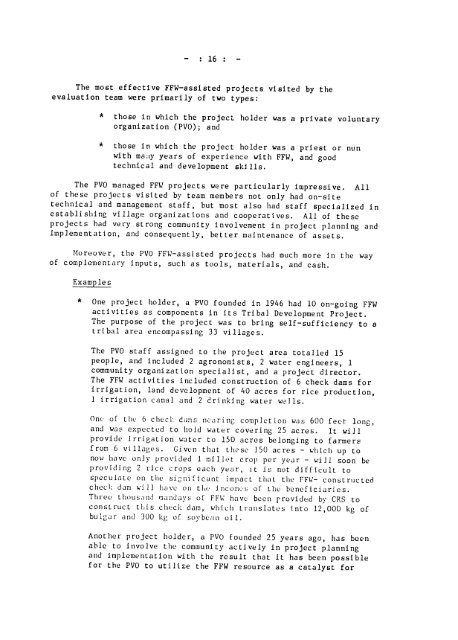(PDF, 101 mb) - USAID
(PDF, 101 mb) - USAID
(PDF, 101 mb) - USAID
Create successful ePaper yourself
Turn your PDF publications into a flip-book with our unique Google optimized e-Paper software.
- : 16 : -<br />
The most effective FFW-assisted projects visited by the<br />
evaluation team were primarily of two types:<br />
* those in which the project holder was a private voluntary<br />
organization (PVO); and<br />
* those in which the project holder was a priest or nun<br />
with maay years of experience with FFW, and good<br />
technical and development skills.<br />
The PVO managed FFW projects were particularly impressive. All<br />
of these projects visited by team me<strong>mb</strong>ers not only had on-site<br />
technical and management staff, but most also had staff specialized in<br />
establishing village organizations and cooperatives. All of these<br />
projects had very strong community involvement in project planning and<br />
Implementation, and consequently, better maintenance of assets.<br />
Moreover, the PVO FFW-assisted projects had much more in the way<br />
of complementary inputs, such as tools, materials, and cash.<br />
Examples<br />
One project holder, a PVO founded in 1946 had 10 on-going FFW<br />
activities as components in its Tribal Development Project.<br />
The purpose of the project was to bring self-sufficiency to a<br />
tribal area encompassing 33 villages.<br />
The PVO staff assigned to the project area totalled 15<br />
people, and included 2 agronomists, 2 water engineers, 1<br />
community organization specialist, and a project director.<br />
The FFW activities included construction of 6 check dams for<br />
irrigation, land development of 40 acres for rice production,<br />
I irrigation canal and 2 drinking water wells.<br />
One of the 6 check dams nearing completion was 600 feet long,<br />
and was expected to hold water covering 25 acres. It will<br />
provide irrigation water to 150 acres belonging to farmers<br />
from 6 villages. Given that these 150 acres - which up to<br />
now have only provided I millet crop per year - will soon be<br />
providing 2 rice crops each year, it is not difficult to<br />
speculate on the significant impact that the FFW- constructed<br />
check dam will have oI tle lncoines of the beneficiaries.<br />
Three thousand ,nandays of FFW have been provided by CRS to<br />
construct this check dam, which translates into 12,000 kg of<br />
bular and 300 kg of soybean oil.<br />
Another project holder, a PVO founded 25 years ago, has been<br />
able to involve the community actively in project planning<br />
and implementation with the result that it has been possible<br />
for the PVO to utilize the FFW resource as a catalyst for

















